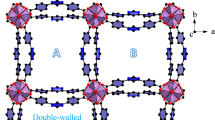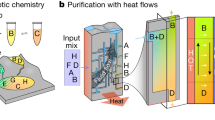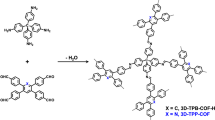Abstract
Industrial development, energy production and mining have led to dramatically increased levels of environmental pollutants such as heavy metal ions, metal cyanides and nuclear waste. Current technologies for purifying contaminated waters are typically expensive and ion specific, and there is therefore a significant need for new approaches. Here, we report inexpensive hybrid membranes made from protein amyloid fibrils and activated porous carbon that can be used to remove heavy metal ions and radioactive waste from water. During filtration, the concentration of heavy metal ions drops by three to five orders of magnitude per passage and the process can be repeated numerous times. Notably, their efficiency remains unaltered when filtering several ions simultaneously. The performance of the membrane is enabled by the ability of the amyloids to selectively absorb heavy metal pollutants from solutions. We also show that our membranes can be used to recycle valuable heavy metal contaminants by thermally reducing ions trapped in saturated membranes, leading to the creation of elemental metal nanoparticles and films.
This is a preview of subscription content, access via your institution
Access options
Subscribe to this journal
Receive 12 print issues and online access
$259.00 per year
only $21.58 per issue
Buy this article
- Purchase on Springer Link
- Instant access to full article PDF
Prices may be subject to local taxes which are calculated during checkout




Similar content being viewed by others

References
Donald, R. L. Water Pollution (San Val, 2002).
Montgomery, M. A. & Elimelech, M. Water and sanitation in developing countries: including health in the equation. Environ. Sci. Technol. 41, 17–24 (2007).
Goel, P. K. Water Pollution: Causes, Effects and Control (New Age International, 2006).
Shannon, M. A. et al. Science and technology for water purification in the coming decades. Nature 452, 301–310 (2008).
Qiu, J. China faces up to groundwater crisis. Nature News 466, 308 (2010).
Ibanez, J. G., Hernandez-Esparza, M., Doria-Serrano, C., Fregoso-Infante, A. & Singh, M. M. Environmental Chemistry: Fundamentals (Springer Science & Business Media, 2010).
Jackson, J. B. C. et al. Historical overfishing and the recent collapse of coastal ecosystems. Science 293, 629–638 (2001).
Mearns, A. J. et al. Effects of pollution on marine organisms. Water Environ. Res. 86, 1869–1954 (2014).
Peters, E. C., Gassman, N. J., Firman, J. C., Richmond, R. H. & Power, E. A. Ecotoxicology of tropical marine ecosystems. Environ. Toxicol. Chem. 16, 12–40 (1997).
La Rivière, J. W. M. la. Threats to the world's water. Sci. Am. 261, 80–94 (1989).
Schwarzenbach, R. P. et al. The challenge of micropollutants in aquatic systems. Science 313, 1072–1077 (2006).
Banks, D., Younger, P. L., Arnesen, R.-T., Iversen, E. R. & Banks, S. B. Mine-water chemistry: the good, the bad and the ugly. Environ. Geol. 32, 157–174 (1997).
Fu, F. & Wang, Q. Removal of heavy metal ions from wastewaters: a review. J. Environ. Manage. 92, 407–418 (2011).
Fu, F. et al. Effective removal of coordinated copper from wastewater using a new dithiocarbamate-type supramolecular heavy metal precipitant. Chemosphere 69, 1783–1789 (2007).
Ghosh, P., Samanta, A. N. & Ray, S. Reduction of COD and removal of Zn2+ from rayon industry wastewater by combined electro-Fenton treatment and chemical precipitation. Desalination 266, 213–217 (2011).
Kurniawan, T. A., Chan, G. Y. S., Lo, W.-H. & Babel, S. Physico-chemical treatment techniques for wastewater laden with heavy metals. Chem. Eng. J. 118, 83–98 (2006).
Barakat, M. A. New trends in removing heavy metals from industrial wastewater. Arabian J. Chem. 4, 361–377 (2011).
Inglezakis, V. J., Stylianou, M. A., Gkantzou, D. & Loizidou, M. D. Removal of Pb(II) from aqueous solutions by using clinoptilolite and bentonite as adsorbents. Desalination 210, 248–256 (2007).
Argun, M. E. Use of clinoptilolite for the removal of nickel ions from water: kinetics and thermodynamics. J. Hazard. Mater. 150, 587–595 (2008).
Shafaei, A., Rezayee, M., Arami, M. & Nikazar, M. Removal of Mn2+ ions from synthetic wastewater by electrocoagulation process. Desalination 260, 23–28 (2010).
Khelifa, A., Moulay, S. & Naceur, A. W. Treatment of metal finishing effluents by the electroflotation technique. Desalination 181, 27–33 (2005).
Vandezande, P., Gevers, L. E. M. & Vankelecom, I. F. J. Solvent resistant nanofiltration: separating on a molecular level. Chem. Soc. Rev. 37, 365–405 (2008).
Huang, J.-H. et al. Adsorption of surfactant micelles and Cd2+/Zn2+ in micellar-enhanced ultrafiltration. J. Hazard. Mater. 183, 287–293 (2010).
Jellouli, E. D., Gzara, L., Ramzi Ben Romdhane, M. & Dhahbi, M. Cadmium removal from aqueous solutions by polyelectrolyte enhanced ultrafiltration. Desalination 246, 363–369 (2009).
Zhang, L., Wu, Y., Qu, X., Li, Z. & Ni, J. Mechanism of combination membrane and electro-winning process on treatment and remediation of Cu2+ polluted water body. J. Environ. Sci. 21, 764–769 (2009).
Murthy, Z. V. P. & Chaudhari, L. B. Application of nanofiltration for the rejection of nickel ions from aqueous solutions and estimation of membrane transport parameters. J. Hazard. Mater. 160, 70–77 (2008).
Krogman, K. C., Lowery, J. L., Zacharia, N. S., Rutledge, G. C. & Hammond, P. T. Spraying asymmetry into functional membranes layer-by-layer. Nature Mater. 8, 512–518 (2009).
Yuan, J. et al. Superwetting nanowire membranes for selective absorption. Nature Nanotech. 3, 332–336 (2008).
Murthy, Z. V. P. & Chaudhari, L. B. Separation of binary heavy metals from aqueous solutions by nanofiltration and characterization of the membrane using Spiegler–Kedem model. Chem. Eng. J. 150, 181–187 (2009).
Rufo, C. M. et al. Short peptides self-assemble to produce catalytic amyloids. Nature Chem. 6, 303–309 (2014).
Banfalvi, G. Cellular Effects of Heavy Metals (Springer Science & Business Media, 2011).
Adamcik, J. et al. Understanding amyloid aggregation by statistical analysis of atomic force microscopy images. Nature Nanotech. 5, 423–428 (2010).
Li, C., Adamcik, J. & Mezzenga, R. Biodegradable nanocomposites of amyloid fibrils and graphene with shape-memory and enzyme-sensing properties. Nature Nanotech. 7, 421–427 (2012).
Bolisetty, S. et al. Amyloid-mediated synthesis of giant, fluorescent, gold single crystals and their hybrid sandwiched composites driven by liquid crystalline interactions. J. Colloid Interf. Sci. 361, 90–96 (2011).
Sahihi, M., Ghayeb, Y. & Khalegh, B. A. Interaction of β-lactoglobulin with resveratrol: molecular docking and molecular dynamics simulation studies. Chem. Biochem. Eng. Q. 27, 417–422 (2013).
Kontopidis, G., Holt, C. & Sawyer, L. β-lactoglobulin: binding properties, structure, and function. J. Dairy Sci. 87, 785–796 (2004).
Akkermans, C. et al. Peptides are building blocks of heat-induced fibrillar protein aggregates of β-lactoglobulin formed at pH 2. Biomacromolecules 9, 1474–1479 (2008).
Goldschmidt, L., Teng, P. K., Riek, R. & Eisenberg, D. Identifying the amylome, proteins capable of forming amyloid-like fibrils. Proc. Natl Acad. Sci. USA 107, 3487–3492 (2010).
Nanda, J., Biswas, A., Adhikari, B. & Banerjee, A. A gel-based trihybrid system containing nanofibers, nanosheets, and nanoparticles: modulation of the rheological property and catalysis. Angew. Chem. Int. Ed. 52, 5041–5045 (2013).
Jung, J.-M., Savin, G., Pouzot, M., Schmitt, C. & Mezzenga, R. Structure of heat-induced β-lactoglobulin aggregates and their complexes with sodium-dodecyl sulfate. Biomacromolecules 9, 2477–2486 (2008).
Acknowledgements
The authors thank C. Zeder (ETHZ) for assistance during AAS measurements, J. Adamcik for atomic force microscopy measurements, S. Handschin for electron microscopy, J. Reuteler for lithography support and S. Assenza (ETHZ) for discussions on adsorption isotherms. Support from the ETHZ Microscopy Center (ScopeM) is gratefully acknowledged. R. Wepf and L. Wyss (ETHZ) are thanked for kindly providing radioactive uranyl acetate and phosphorus-32, respectively.
Author information
Authors and Affiliations
Contributions
S.B. performed the experiments, analysed the results and wrote the manuscript. R.M. designed the study, analysed the data and wrote the manuscript. Both authors discussed the results and commented on the manuscript.
Corresponding author
Ethics declarations
Competing interests
The authors are the inventors of a patent filed by ETH Zurich related to the work presented here (EP2921216 and WO2015140074).
Supplementary information
Supplementary information
Supplementary information (PDF 4456 kb)
Rights and permissions
About this article
Cite this article
Bolisetty, S., Mezzenga, R. Amyloid–carbon hybrid membranes for universal water purification. Nature Nanotech 11, 365–371 (2016). https://doi.org/10.1038/nnano.2015.310
Received:
Accepted:
Published:
Issue Date:
DOI: https://doi.org/10.1038/nnano.2015.310
This article is cited by
-
Wheat flour-derived amyloid fibrils for efficient removal of organic dyes from contaminated water
Bioresources and Bioprocessing (2024)
-
Synthesis and functionalization of scalable and versatile 2D protein films via amyloid-like aggregation
Nature Protocols (2024)
-
Efficacy of polymeric nanofibrous membranes for proficient wastewater treatment
Polymer Bulletin (2023)
-
A novel covalent organic framework with abundant N-O-O and N-N-O sites for detection and removal of Zn2+, Cd2+, Pb2+, Cu2+, and Hg2+
Ionics (2023)
-
A thermal-responsive hydrogel to capture uranium(VI) from aqueous solution: properties and mechanism
Journal of Radioanalytical and Nuclear Chemistry (2023)


